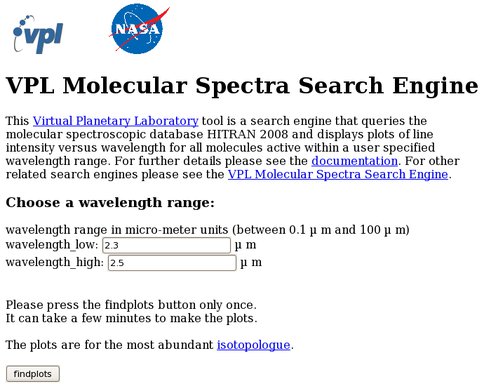2012 Annual Science Report
 VPL at University of Washington
Reporting | SEP 2011 – AUG 2012
VPL at University of Washington
Reporting | SEP 2011 – AUG 2012
VPL Databases, Model Interfaces and the Community Tool
Project Summary
The Virtual Planetary Laboratory (VPL) develops computer models of planetary environments, including planets orbiting other stars (exoplanets) and provides a collaborative framework for scientists from many disciplines to coordinate their research. As part of this framework, VPL develops easier to use interfaces to its models, and provides model output datasets, so that they can be used by more researchers. We also collect and serve to the community the scientific data required as input to the models. These input data include spectra of stars, data files that tell us how atmospheric gases interact with incoming stellar radiation, and plant photosynthetic pigments. We also develop tools that allow users to search and manipulate the scientific input data. This year we provided Earth model datasets, new tools for searching the molecular spectroscopic database, and a new database of biological pigments. All of these products and others are published on the VPL Team Website at: http://depts.washington.edu/naivpl/content/models-spectra.
Project Progress
We have made significant progress during the reporting period in developing Spectral Databases and Tools. These databases and tools are publicly available on the below VPL website: http://depts.washington.edu/naivpl/content/spectral-databases-and-tools
We have developed a molecular spectra search engine. High resolution molecular spectra such as HITRAN spectra have a large dynamic range and fine details. Static plots cannot cover the whole wavelength range of the spectra and at the same time show the fine details. Our molecular spectra search engine allows the user to query the HITRAN data and find out molecules which have spectral features in a give wave number or wavelength range. The user can view the spectra of the molecules and zoom in to look at details of the spectra or zoom out to look at the big picture. The user can then identify molecules that correspond to spectroscopic features in spectra obtained by spacecraft or telescopes.
The planetary spectra data obtained by the VPL earth model has been made public and is available on the VPL spectral database and tools website. There are two spectral data sets: VPL Model Spectra for 3 EPOXI Observation Dates and VPL Model Spectra for Earth Through An Orbit. The planetary spectra includes both spatially and temporally resolved synthetic spectra of Earth, validated with visible photometric and moderate resolution near-infrared observations from NASA’s EPOXI spacecraft. We have used our model to generate both 24-hour disk-averaged spectra for the dates of the EPOXI observations; as well as spectra taken over the course of an entire orbit. The model takes into account realistic scattering, absorption, and emission from the atmosphere, clouds, and surface, and is described in Robinson et al. (2011).
Finally, we have developed a Biological Pigments Database. This database of spectral absorbance or absorption coefficients of biological pigments includes but is not limited to photosynthetic pigments and screening compounds for protection against radiation. The database contains the absorbance data in ASCII format and the plots based on the absorbance data. The user can look at the plot for any given pigment. If they find it relevant to their research then they can download the ASCII data. Each pigment includes a detailed description of journal references and information about the absorbance data.
A screenshot of the VPL molecular spectra search engine for searching by
wavelength, http://vplapps.astro.washington.edu/vplselectmicro. Clicking
on the “findplots” button returns a list of plots of molecular spectra for
molecules which have non-zero line intensities in the range specified by the
user. Users who prefer to search by wavenumber range can use the site
http://vplapps.astro.washington.edu/vplrange.
-
PROJECT INVESTIGATORS:
-
PROJECT MEMBERS:
John Armstrong
Co-Investigator
Rory Barnes
Co-Investigator
David Crisp
Co-Investigator
Shawn Domagal-Goldman
Co-Investigator
Antigona Segura-Peralta
Co-Investigator
Nicole Evans
Undergraduate Student
-
RELATED OBJECTIVES:
Objective 1.1
Formation and evolution of habitable planets.
Objective 1.2
Indirect and direct astronomical observations of extrasolar habitable planets.
Objective 3.2
Origins and evolution of functional biomolecules
Objective 4.1
Earth's early biosphere.
Objective 6.1
Effects of environmental changes on microbial ecosystems
Objective 7.1
Biosignatures to be sought in Solar System materials
Objective 7.2
Biosignatures to be sought in nearby planetary systems




